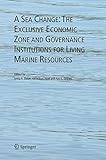A Sea Change: The Exclusive Economic Zone and Governance Institutions for Living Marine Resources [electronic resource] / edited by Syma A. Ebbin, Alf Håkon Hoel, Are K. Sydnes.
Publisher: Dordrecht : Springer Netherlands, 2005Description: XIV, 224 p. online resourceContent type:- text
- computer
- online resource
- 9781402031335
- 333.7 23
- HC79.E5
 eBooks
eBooks
Overview -- Ocean Governance and Institutional Change -- A Brief Introduction to the Principal Provisions of the International Legal Regime Governing Fisheries in the EEZ -- National Strategies for EEZ Implementation -- The Performance of Exclusive Economic Zones -- Fisheries Management in the Russian Federation -- Integrated Oceans Management and the Institutional Performance of Exclusive Economic Zones -- The Impact of the EEZ on Pacific Salmon Management -- Regulating Access and the Use of Marine Genetic Resources within the Exclusive Economic Zone -- Regional Strategies for Coordinating the EEZ Regime -- Regional Fisheries Organisations and International Fisheries Governance -- Exclusive Economic Zones and the Management of Fisheries in the South China Sea -- Staking Their Claims: The Management of Marine Resources in the Exclusive Economic Zones of the Pacific Islands -- A Changing Sea: New and Emerging Institutional Directions for the EEZ -- FAO’S Fisheries Programme and the Plan of Implementation of the World Summit on Sustainable Development -- Governing the Bering Sea Region -- Changing Seas, Changing Institutions: Charting New Courses into the Future.
A Sea Change in a Changing Sea The oceans, seas and coastal areas encompass over 70% of the earth’s surface. They are a critical driver of the earth’s hydrologic cycle and climate system, important for c- merce, transport, and tourism, a source of economically important living marine resources, minerals such as hydrocarbons, as well as new pharmaceutical compounds. The marine environment provides essential habitats for thousands of marine living 1 2 resources, which in turn contribute significantly to global food security, employment, 3 and trade. Overall, the sea’s contribution to human welfare, in terms of market and non-market resources and environmental services, has been estimated at US$21 trillion/year (Costanza, 2000). However, despite the importance of the ocean realm to humans, there is a growing sense that human impacts are destabilizing this system. Some experts believe that current fishing levels are approaching or exceeding the total 4 productivity of the ocean ecosystem (National Research Council, 1999).


